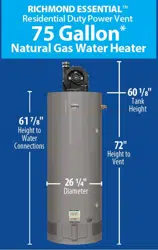Loading ...
Loading ...
Loading ...

11
WARNING: DO NOT attempt to convert this water heater for use with a different type of gas other than the type
shown on the rating plate. Such conversion could result in hazardous operating conditions.
High Altitude
Input rating of this water heater is based on
sea level operation. At higher elevations
the actual input rate may be lower than the
value listed on the rating label due to the
derating of natural gas and LP gas. This
water heater can be installed at elevation
up to 2000 feet without any change or
modification.
For installation between 2000 and 7700
feet, refer to the Venting Information tables
on page 14 for maximum equivalent vent
lengths.
Installations above 7700 feet are not
authorized.
Contact the local gas supplier for more
information.
Pressure Testing the Gas Supply System
The water heater and its individual shutoff
valve must be disconnected from the gas
supply piping system during any pressure
testing of that system at test pressures in
excess 1/2 psi (3.5 kPa).
The water heater must be isolated from
the gas supply piping system by closing
its individual manual gas shutoff valve
during any pressure testing of the gas
supply at test pressures equal to or less
than 1/2 psi (3.5 kPa).
Gas Supply
The branch gas supply line to the water
heater should be clean 1/2 in. black steel
pipe or other approved gas piping material.
A union or ANSI design certified semi-
rigid or flexible gas appliance connector
should be installed in the gas line close to
the water heater. The National Fuel Gas
Code (NFGC) mandates a manual gas
shut-off valve: See (NFGC) for complete
instructions.
If flexible connectors are used, the
maximum length shall not exceed 36 in.
and must meet the requirements in ANSI
Z21.24-Connectors for Gas Appliances.
Compound used on the threaded joints of
the gas piping must be of the type resistant
to the action of LP gas. Use compound
sparingly on male threads only.
Where a sediment trap is not incorporated
as part of the appliance, a sediment trap
shall be installed downstream of the
equipment shutoff valve as close to the
inlet of the appliance as practical at the
time of the appliance installation. The
sediment trap shall be either a tee fitting
with a capped nipple in the bottom outlet
or other device recognized as an effective
sediment trap.
DO NOT use excessive force (over 31.5
ft•lbs.) (42.70 N•m) in tightening the pipe
joint at the Combination Gas Control
(Thermostat) inlet, particularly if Teflon
pipe compound is used, as the valve body
may be damaged.
The inlet gas pressure to the water heater
must not exceed 14 in. w.c. for natural gas,
or 14 in. w.c. for LP gas. For purposes of
input adjustment, the minimum inlet gas
pressure (with main burner on) is shown on
the water heater rating plate. If high or low
gas pressures are present, contact your gas
supplier for correction.
Leak Testing
The water heater and its gas connections
must be leak tested at normal operating
pressures before it is placed in operation.
Turn on the manual gas shut-off valve
near the water heater.
Use a soapy water solution to test for
leaks at all connections and fittings.
Bubbles indicate a gas leak that must
be corrected.
The factory connections to the gas control
(thermostat) should also be leak tested after
the water heater is placed in operation.
WARNING: Never use
an open flame to test for
gas leaks, as property
damage, personal injury,
or death could result.
WARNING: Failure to
install a water heater
suitable for the altitude at
the location it is intended
to serve, can result in
improper operation of the
appliance resulting in
property damage and/or
producing carbon
monoxide gas, which
could result in personal
injury, or death.
Loading ...
Loading ...
Loading ...
